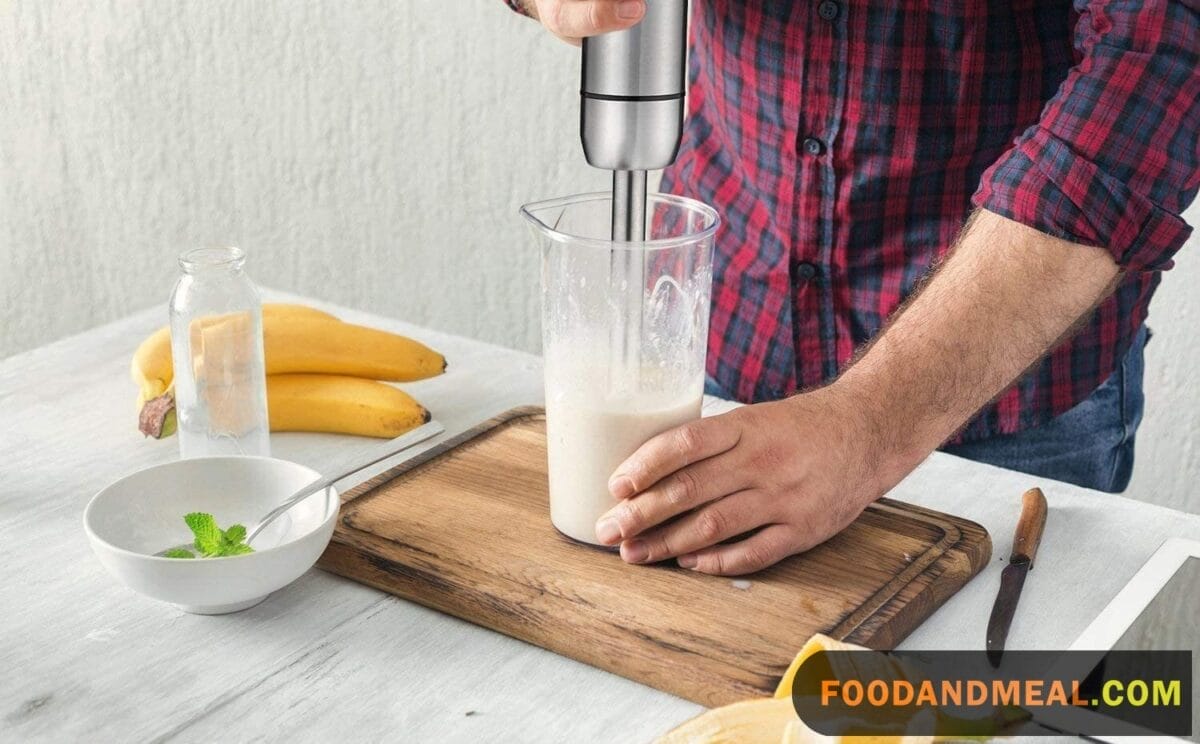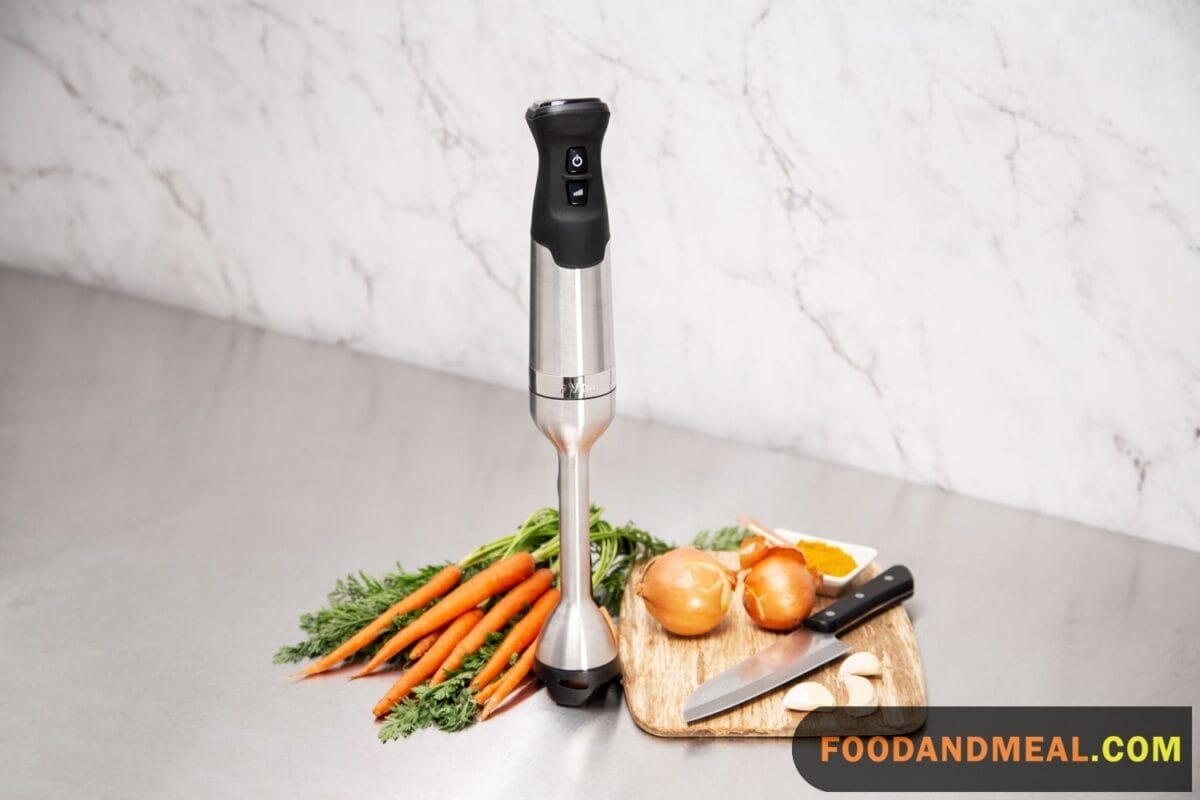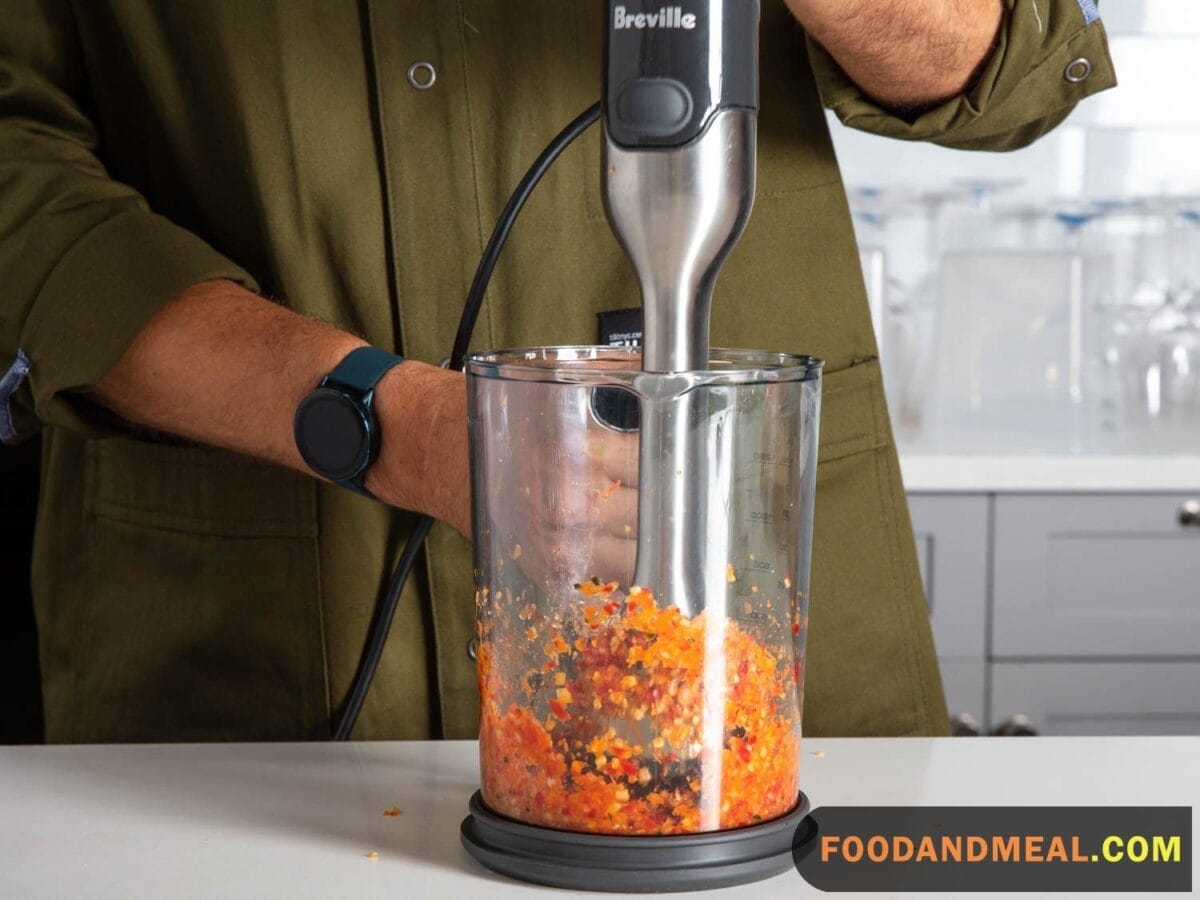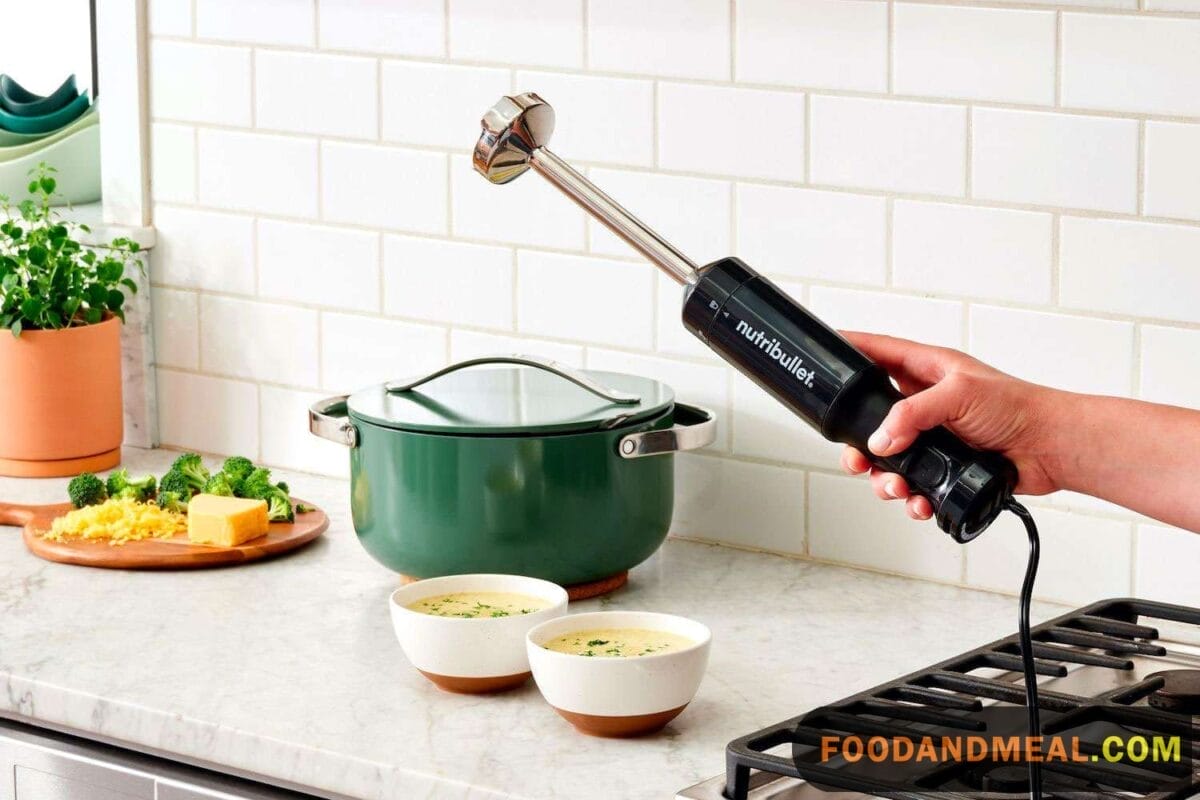Planning to crush ice for a frozen cocktail? Opt for the full-sized blender. Craving a swift morning smoothie for your commute? Grab your personal-sized blender with its convenient on-the-go jar. However, when the menu includes soup or mashed potatoes, the tool of choice is the immersion blender. Whether whipping up scrambled eggs, a peach smoothie, or butternut squash soup, the immersion blender excels in versatility and functionality.
What Is an Immersion Blender?
The immersion blender, a versatile kitchen tool often referred to as a stick blender or hand blender, stands out with its handheld design. It comprises a sleek handle-grip top, a baton-like shaft, and a spinning blade covered by a protective guard at the bottom. This unique combination of features gives it a distinctive long cylindrical shape. Available in both plug-in and cordless variations, the immersion blender is engineered to be a complementary tool in your kitchen arsenal, working alongside, rather than replacing, your countertop blender.
Mark Zoch, an expert overseeing blender testing at CR, articulates the immersion blender’s prowess, stating, “An immersion blender combines the attributes of an automatic blender or mixer with the manual stirring motion of a spoon.” This amalgamation of automatic and manual functionalities makes the immersion blender a versatile and efficient tool for various culinary tasks.
Unlike traditional countertop blenders, the immersion blender’s design allows for convenient, on-the-spot blending and mixing. Its handheld nature provides greater control and precision, allowing you to immerse it directly into pots, pans, or bowls. This makes it particularly handy for tasks like pureeing soups, sauces, or even making smoothies without the need for transferring ingredients.
The long, cylindrical shape of the immersion blender is not merely an aesthetic choice; it serves a functional purpose. This design enables the blender to reach into deeper containers and navigate through ingredients with ease, ensuring thorough blending and mixing. The spinning blade, situated at the end of the shaft, is adept at processing a variety of textures, from soft fruits to tougher vegetables.
The immersion blender’s adaptability extends beyond the realm of blending. Its manual stirring motion capability allows for gentle mixing or emulsifying, making it a valuable tool for tasks like whipping cream, beating eggs, or preparing salad dressings. This dual functionality consolidates the features of both automatic and manual kitchen tools into one convenient device.
Whether you’re a culinary enthusiast or a casual home cook, the immersion blender proves to be a versatile and indispensable asset in the kitchen. Its ergonomic design, coupled with the ability to seamlessly transition between blending and stirring, makes it a go-to tool for a wide range of recipes. As kitchens evolve to accommodate more diverse cooking styles, the immersion blender stands out as a reliable and adaptable companion in the quest for culinary excellence.
What Is an Immersion Blender Used For?
At Food And Meal, we have tested various immersion blenders to evaluate their performance. In our experience, we have found them to be extremely versatile appliances that allow us to blend and mix foods right in their containers. We love how easily immersion blenders let us make salad dressings, whip pancake batter, and purée soups and stews.

When using immersion blenders, we feel they provide great convenience thanks to their compact size and blade guard that lets us blend safely in pots and bowls. We also appreciate available attachments like whisks and choppers that expand what we can make. In testing smoothies, we were pleased that most models smoothly puréed frozen fruit and yogurt. However, we did notice limitations in their power when trying thicker mixtures compared to our countertop blenders.
Overall, we highly recommend immersion blenders as useful kitchen tools based on our many positive experiences. We view them as great complements to traditional blenders, allowing us to tackle more blending tasks directly in cooking vessels. We enjoy the flexibility they give us to experiment with new recipes requiring emulsification or mixing. We will definitely continue using our trusty immersion blenders for soups, dressings, and other homemade foods requiring a quick blend.
How to Use an Immersion Blender
In our experience, mastering the use of an immersion blender is an uncomplicated process that offers versatility in our kitchen endeavors. To initiate the blending process, we submerge the blender’s blade entirely into the food or beverage we wish to mix before activating the appliance. This ensures that the blending action is concentrated on the ingredients within the container.
As we switch on the immersion blender, we gently move the device around the container, allowing the blade to interact with all the contents comprehensively. Maintaining the blade’s submersion during this process is essential to prevent any splattering and to guarantee an even blend.

According to Mark Zoch, who simplifies the technique, “It’s simple. Just switch the device on and swirl the stick around to blend.” While the immersion blender involves a more manual approach compared to a full-sized blender, it compensates with a streamlined and less messy operation. The hands-on nature of the immersion blender grants us precise control over the blending process, making it suitable for various culinary tasks.
Moreover, one of the notable advantages of using an immersion blender lies in its minimal cleanup requirements. Unlike larger blenders, the immersion blender’s design allows for direct immersion into pots, pans, or bowls, eliminating the need for additional vessels. This not only saves time but also reduces the number of utensils and dishes to wash, making it a convenient choice for quick and efficient blending.
In essence, the simplicity of using an immersion blender, coupled with its manual control and easy cleanup, positions it as a valuable tool in our kitchen. Whether we’re blending soups, sauces, or beverages, the immersion blender offers a user-friendly and efficient solution for achieving the desired consistency in our culinary creations.
Tips for Using an Immersion Blender

Why Should You Use an Immersion Blender?
| Convenience | The handheld blender’s compact and user-friendly design, easily fitting in the palm of your hand with simple button controls, ensures convenience. The absence of a jar simplifies the cleaning process compared to other blender types. |
| Portability | The small size of handheld blenders makes them highly portable. This proves advantageous for on-the-go situations, allowing you to pack the blender for holiday gatherings or trips. For example, it’s a useful tool for preparing gravy during Thanksgiving dinner away from home. |
| Easy Storage | The immersion blender’s small footprint makes it easy to store. It effortlessly fits into kitchen cabinets or drawers, contributing to a neat and organized kitchen space. |
| Stovetop Use | The immersion blender’s key feature is its ability to blend directly in a stockpot on the stovetop. This streamlines cooking, enhances safety by minimizing hot ingredient handling, and offers a practical solution for efficient blending. |
Best Immersion Blender, Reviews by Food and Meal
Below are some best immersion blender which Food and Meal thinks it’s suitable for you:
FAQs about Using an Immersion Blender
- What is an immersion blender, and how does it work? An immersion blender is a handheld kitchen appliance used for blending and pureeing. It consists of a motorized handle with a rotating blade at the end. To use it, immerse the blade directly into the ingredients and activate the motor.
- What can I use an immersion blender for? Immersion blenders are versatile and can be used for blending soups, sauces, smoothies, and other liquids directly in the pot or container. They are also suitable for making whipped cream and emulsifying dressings.
- How do I assemble an immersion blender? Assembling an immersion blender typically involves attaching the blending attachment to the motorized handle. Follow the manufacturer’s instructions for your specific model.
- Can I use an immersion blender in hot liquids? Yes, immersion blenders are designed to handle hot liquids. However, it’s essential to use caution and avoid splashing. Keep the blade fully immersed to prevent any mishaps.
- Do I need to chop ingredients before using an immersion blender? While immersion blenders can handle larger pieces of food, it’s generally advisable to chop ingredients into smaller pieces for more efficient blending, especially for dense or fibrous items.
- Can I use an immersion blender in non-stick cookware? It’s recommended to avoid using immersion blenders directly in non-stick cookware, as the blades may scratch the surface. Instead, transfer the ingredients to a different container for blending.
- How do I clean an immersion blender? Most immersion blender attachments are detachable and dishwasher-safe. Alternatively, you can clean them by detaching the blending attachment and washing it with warm, soapy water.
- Can I use an immersion blender for crushing ice? While some immersion blenders come with ice-crushing attachments, not all are suitable for this purpose. Check the manufacturer’s instructions to determine if your blender is designed for crushing ice.
- Can I use an immersion blender to make smoothies? Yes, immersion blenders are excellent for making smoothies. Simply place the blender in the container with your smoothie ingredients and blend until you achieve the desired consistency.
- Are there safety precautions when using an immersion blender? Always ensure the blender is turned off before immersing or removing it from liquids. Be cautious with hot liquids, and follow the manufacturer’s safety guidelines for your specific immersion blender model.
In conclusion, immersion blenders emerge as versatile kitchen companions, excelling in convenience, portability, easy storage, and especially their suitability for stovetop use. Their compact design, simple controls, and jar-less operation make them a practical choice for users seeking efficiency in blending tasks. The ability to blend directly in a stockpot not only streamlines the cooking process but also enhances safety by minimizing the handling of hot ingredients. Whether you’re at home or on the go, immersion blenders prove to be reliable and adaptable tools, offering a seamless and enjoyable cooking experience.



